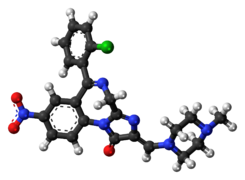Loprazolam
 |
|
 |
|
| Clinical data | |
|---|---|
| Trade names | Dormonoct |
| AHFS/Drugs.com | International Drug Names |
| Pregnancy category |
|
| Routes of administration |
Oral |
| ATC code | |
| Legal status | |
| Legal status |
|
| Pharmacokinetic data | |
| Metabolism | Hepatic |
| Biological half-life | 6–12 hours |
| Excretion | Renal |
| Identifiers | |
|
|
| CAS Number | |
| PubChem CID | |
| DrugBank | |
| ChemSpider | |
| UNII | |
| KEGG | |
| Chemical and physical data | |
| Formula | C23H21ClN6O3 |
| Molar mass | 464.904 g/mol |
| 3D model (Jmol) | |
|
|
|
|
|
|
|
Loprazolam (triazulenone) marketed under the brand names Dormonoct, Havlane, Sonin and Somnovit, is a drug which is an imidazolobenzodiazepine derivative. It possesses anxiolytic, anticonvulsant, hypnotic, sedative and skeletal muscle relaxant properties. It is available in 1 mg and 2 mg tablets. It is licensed and marketed for the short-term treatment of moderately-severe insomnia.
Insomnia can be described as a difficulty falling asleep, frequent awakening, early awakenings or a combination of each. Loprazolam is a short-acting benzodiazepine and is sometimes used in patients who have difficulty in maintaining sleep or have difficulty falling asleep. Hypnotics should only be used on a short-term basis or in those with chronic insomnia on an occasional basis.
The dose of loprazolam for insomnia is usually 1 mg but can be increased to 2 mg if necessary. In the elderly a lower dose is recommended due to more pronounced effects and a significant impairment of standing up to 11 hours after dosing of 1 mg of loprazolam. The half-life is much more prolonged in the elderly than in younger patients. A half-life of 19.8 hours has been reported in elderly patients. Patients and prescribing physicians should, however, bear in mind that higher doses of loprazolam may impair long-term memory functions.
Side effects of loprazolam are generally the same as for other benzodiazepines such as diazepam. The most significant difference in side effects of loprazolam and diazepam is it is less prone to day time sedation as the half-life of loprazolam is considered to be intermediate whereas diazepam has a very long half-life. The side effects of loprazolam are the following:
Residual 'hangover' effects after nighttime administration of loprazolam such as sleepiness, impaired psychomotor and cognitive functions may persist into the next day which may increase risks of falls and hip fractures.
Loprazolam, like all other benzodiazepines, is recommended only for the short-term management of insomnia in the UK, owing to the risk of serious adverse effects such as tolerance, dependence and withdrawal, as well as adverse effects on mood and cognition. Benzodiazepines can become less effective over time, and patients can develop increasing physical and psychological adverse effects, e.g., agorophobia, gastrointestinal complaints, and peripheral nerve abnormalities such as burning and tingling sensations.
...
Wikipedia
